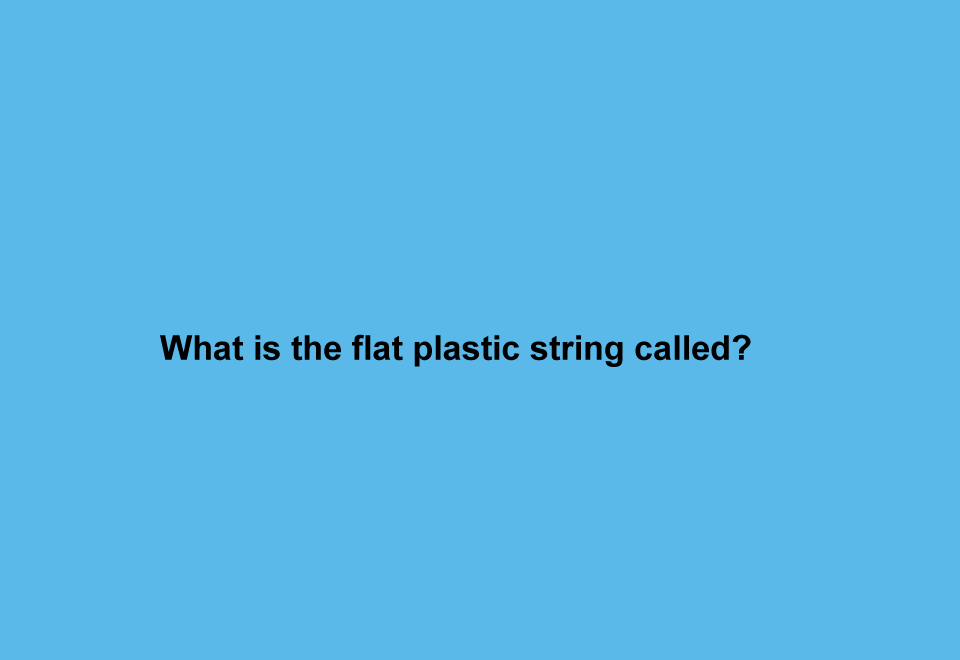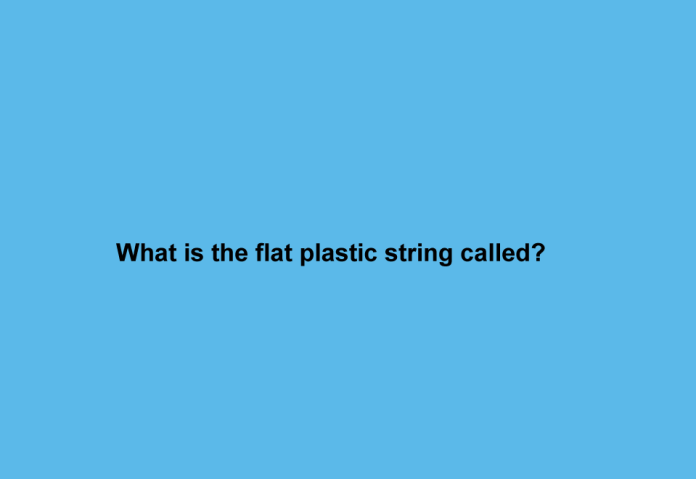The flat plastic string call you’re referring to is often called a “flat plastic strap” or a “plastic band.” It can be used for various purposes, such as bundling items together, securing packages, or even in craft projects. Depending on its specific characteristics and use, it might also be known by brand names or specific terms related to its intended function, like “zip ties” or “cable ties” if it’s designed for fastening and securing objects.

What is gimp string?
It seems there might be a slight confusion in your terminology. “Gimp” typically refers to a type of flat, twisted silk or cotton cord, often used for making braids, jewelry, or other crafts. It can also refer to a flat plastic lace used in crafting projects, especially in making lanyards and keychains.
If you’re referring to a specific type of string or cord used in a particular context, it would be helpful to provide more details for clarification.
What are those plastic strings called?
If you’re referring to the plastic strings commonly used in crafting, especially for making lanyards, keychains, and similar items, they are often called “craft lace” or “plastic lace.” Another commonly used term for these strings is “boondoggle.” These plastic strings come in various colors and are often flat and shiny, making them popular for creating woven or braided patterns in crafts.
What are those string keychains called?
The keychains made from plastic strings, often woven or braided, are commonly known as “lanyards” or “keychain lanyards.” These lanyards are frequently made using materials like craft lace or plastic lace. They can be crafted in various patterns and colors, and some people also refer to them as “boondoggle keychains” or simply “plastic string keychains” based on the materials used in their construction.
Why is gimp string called gimp?
The term “gimp” in the context of crafting refers to a type of flat, twisted silk or cotton cord, or sometimes a flat plastic lace used in crafting projects like making braids, jewelry, or keychains. The origin of the term “gimp” in this context is not entirely clear, and it doesn’t have a single, universally agreed-upon explanation.
One theory is that the term “gimp” in this context might have originated from the French word “guimpe,” which refers to a decorative fabric trimming. Over time, the term evolved and came to be associated with the flat cords used in various crafts.
It’s worth noting that “gimp” can have different meanings in different contexts, and the usage of the term may vary across regions and communities.
What is buttonhole gimp?
“Buttonhole gimp” typically refers to a type of cord or thread used in sewing to reinforce and create a sturdy edge for buttonholes. It is often a thicker and more robust material than regular sewing thread.
When making buttonholes in fabric, especially on heavy or thick fabrics, buttonhole gimp is used to add structure and strength to the buttonhole edges. It helps prevent fraying and ensures that the buttonhole maintains its shape over time, despite the stress and movement it may experience during use.
Buttonhole gimp can be made from various materials, including cotton, silk, or synthetic fibers, depending on the desired strength and appearance. It is usually thicker than regular sewing thread to provide the necessary reinforcement for buttonholes.
What is the longest gimp in the world?
As of my last knowledge update in January 2022, I don’t have specific information about the longest gimp in the world. Determining the “longest gimp” would likely depend on the context of what is being measured—whether it’s a particular craft project, a piece of gimp cord, or some other form of gimp.
If there have been developments or records set since my last update, I recommend checking the latest sources, records, or relevant databases for the most current information on the longest gimp in the world. Keep in mind that the concept of the “longest gimp” might vary based on different criteria, so specifying the context can be important when searching for such records.
What is the string called to make bracelets?
The string used to make bracelets can vary depending on the type of bracelet and the desired look and feel. Common types of strings or threads used for bracelet-making include:
Embroidery Floss: This is a popular choice for making friendship bracelets. It comes in a variety of colors, is relatively inexpensive, and is easy to work with.
Nylon Cord or Satin Cord: These cords are often used for more durable and sleek-looking bracelets. They come in various thicknesses and colors.
Leather Cord: For a more natural or rustic look, leather cord can be used. It’s available in different sizes and colors.
Hemp Cord: Hemp is a natural fiber that can be used to create a variety of bracelet designs. It’s often associated with bohemian or earthy styles.
Stretch Cord or Elastic Cord: Ideal for beaded bracelets, stretch cord allows the bracelet to stretch and easily fit over the hand.
Wire: For more advanced jewelry making, wire can be used to create intricate designs.
Waxed Cotton Cord: This type of cord has a wax coating, making it water-resistant and more durable.
Silk Thread: It’s a fine and smooth thread often used for delicate and intricate beadwork.
When choosing a string for your bracelet, consider the design, durability, and the look you want to achieve. Different types of bracelets may require different materials for optimal results.
What can you do with plastic lacing?
Plastic lacing, often referred to as craft lace or gimp, is a versatile material that can be used for a variety of creative projects. Here are some common activities and crafts you can do with plastic lacing:
Lanyards: Create colorful lanyards by braiding or weaving plastic lacing. These lanyards can be used for holding keys, badges, or as decorative accessories.
Keychains: Make personalized keychains by crafting plastic lacing into different shapes and patterns. You can add beads, charms, or other embellishments for a unique touch.
Bracelets: Weave plastic lacing to make bracelets of various styles. You can experiment with different weaving techniques, colors, and bead combinations to create customized jewelry.
Bookmarks: Craft bookmarks by braiding or twisting plastic lacing. Add beads or charms to make them more visually appealing.
Zipper Pulls: Use plastic lacing to create custom zipper pulls for bags, jackets, or other items with zippers.
Camping Crafts: Plastic lacing is a durable material, making it suitable for crafting practical items like zipper pulls for camping gear or even makeshift handles for small camping tools.
Animal Figures: Make simple animal figures or keychain charms by shaping and twisting plastic lacing into desired shapes.
Basket Weaving: Explore more advanced projects by using plastic lacing to create small baskets or containers. This can involve intricate weaving patterns.
Headbands: Design headbands by braiding or weaving plastic lacing. Add embellishments like beads or bows for a stylish finish.
DIY Jewelry: Create various jewelry items such as necklaces, earrings, or anklets using plastic lacing and incorporating other materials like beads and charms.
Friendship Bracelets: Use plastic lacing to make friendship bracelets in different patterns and styles. These can be great personalized gifts for friends.
Remember to experiment with different colors, patterns, and techniques to add your own creative flair to the projects. Plastic lacing is a fun and affordable material for a wide range of craft activities.
What is lanyard string?
“Lanyard string” typically refers to the material used to make lanyards, which are often flat, woven cords used for various purposes such as holding identification badges, keys, or other small items. The material used for lanyards can vary, but it is often a type of cord or string that is durable and capable of supporting the weight of items attached to it.
Common materials for lanyard strings include:
Nylon Cord: Nylon is a strong and durable material commonly used for lanyards. It is available in various colors and thicknesses.
Polyester Cord: Like nylon, polyester is another durable material suitable for lanyards. It has a smooth texture and can be found in different colors.
Paracord: Paracord, or parachute cord, is a versatile and strong cord originally used for parachutes. It comes in various colors and patterns and is often used for crafting lanyards.
Cotton Cord: Cotton can be used for lanyards, especially for those who prefer a natural fiber. However, it may not be as durable as synthetic options.
Braided Leather Cord: For a more stylish and sophisticated look, some lanyards use braided leather cords.
When making lanyards as a craft project, you can choose the type of string or cord based on your preferences for appearance, texture, and durability. Additionally, lanyards can be customized with various weaving techniques, colors, and embellishments to create unique and personalized accessories.


